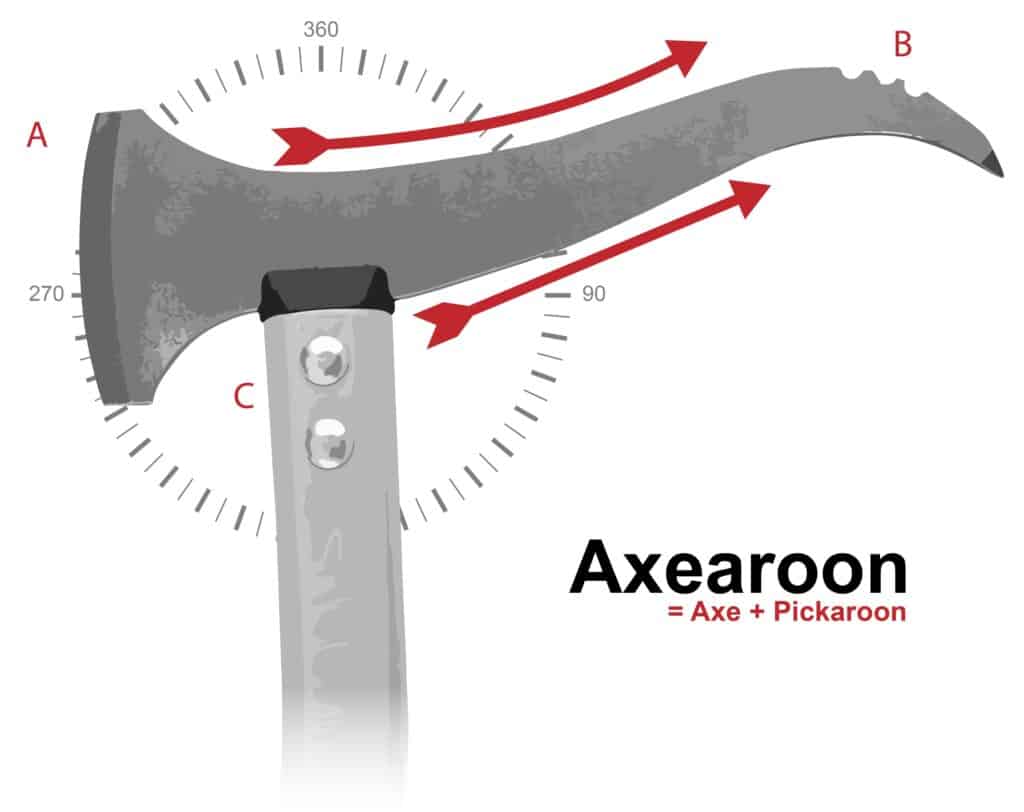You know when you have an idea that looks good on paper, but in reality, it is far less effective than you thought it would be? Well, that’s an axearoon. The marriage of an axe and a pickaroon whose offspring just doesn’t live up to the hype and expectations. Awkward at best, and dangerous at worst, the axearoon has really only one practical application, firewood handling/processing (but in a very limited capacity).

Axearoon: A hybred logging tool that combines an small axe and pickaroon into a two sided logging tool. Most frequently used by firewood processors to moving and position bucked, split logs, and perform light chopping.
The Axearoon Delema
The creator of the axearoon intentions was good. Reduce effort and increase efficiency by combining two common logging tools, the axe, and the pickaroon into one streamlined tool. Use the axearoon’s hooked/spiked side to move small rounds and bucked logs without bending over. Flip the head over and use the axe side for chopping and splitting the same material. The only problem is these two tools have conflicting build characteristics. The end result is a heavy hookaroon and an anemic axe.
By design, a pickaroon is lightweight. A long handle and minimalist spiked hook allow the user to move rounds and bucked logs short distances with ease. Perfect for unloading trucks, loading log splitters, and stacking wood. When used correctly, a hookaroon can reduce fatigue and speed up many repetitive tasks.
To be as efficient as possible It is essential that the spike/hook be of minimal mass so that it does not embed too deeply into the material being moved. The shallow but strong grip of the hook allows the user to set it quickly and remove it with minimal effort. A good pickaroon will bite just enough to do the job and no more.
In contrast, an effective axe head needs adequate mass. The weight of the head is proportional to the amount of force it can generate when it is swung. So by necessity, when chopping or splitting wood with an axe, a heavier head is more effective than a lighter one. An axe head that is too light is inefficient, requiring more strikes, and resulting in increased time and effort. Obviously, there are limits to the human body so the law of diminishing returns applies as an axe head gets heavier.
By combining the axe and the pickaroon, we now have a tool that is a jack of all trades and a master of none. An axe that is too light to efficiently chop/split wood and a pickaroon that is too heavy for efficient wood handling. Both sides of the tool are compromising to allow for the existence of the other on the same handle at the expense of their core efficiencies.
Safety First
Putting the axearoon’s fundamental flaws aside, one additional issue is forever present. How to use an axearoon safely? A razor-sharp axe head opposite a spiked hook can pose some serious safety challenges while navigating around the woodpile. Each business end of the axearoon can be dangerous in its own right. For this reason, an axearoon is not well suited for moving a large amount of material over a distance. There are way too many opportunities for injuries resulting from brushing up against the axe blade, or a trip and fall.
Note: Do not confuse the Axearoon with a Pulaski. A Pulaski combines an axe with an adze for use by wildland firefighters to chop wood and dig the soil to construct fire breaks.
What is the Axearoon good for?
Seemingly doomed from the start, this relatively obscure tool is best suited for processing firewood with a wood splitter or other automated processor. The pickaroon side is perfect for hoisting logs and rounds into the splitter. The increased reach allows the operator to move less, conserving energy. The axe side comes in handy when a log needs to be cleaned up (removing any remaining branches before splitting), reshaping a log to fit into the machine, and finishing incompletely split logs. In this scenario, the Axearoon shines. The weaknesses described above are mitigated by using both sides of the tool in a limited capacity. The hook is used to pick up logs from the ground, and the axe is used more as a hatchet. Neither is being used to their full capabilities but in this circumstance, it’s enough to make it useful.
What to look for when buying an Axearoon
If you decide to purchase an axearoon to help with firewood processing it is important that it is both ergonomic and sized for you and your intended use. Accounting for the three areas below will help you choose the best axearoon for your needs.
Handle length
The handle should be long enough to use the pickaroon without bending down, as well as be long enough to make a full swing of the axe. Shorter handles will reduce the effectiveness of the tool.
Hook/spike size and shape
The hook shouldn’t be overly thick, have a slight taper, and have a downward bend at the tip towards the handle to make releasing the wood easy. If it is not tapered or is too thick it will require more effort or even a back-and-forth motion to remove it from the wood. Over time this will reduce efficiency and increase fatigue.
Axe size and weight
Resist the temptation to have a full-size splitting axe head. There are a lot of double-bite axe conversions where one of the faces is reshaped into a pickaroon. This axearoon is never going to be your go-to splitting axe, so the added weight of a full-size head is just going to get in the way. Look for a boy or woodsman size head. The reduced size and weight will make it easier to use while still having enough mass to be effective.
Summary
The axearoon has always been a compromise and as a result, is generally considered an obscure or specialty tool. However, if you process a lot of firewood using a wood splitter then this just might be the right tool for the job.
